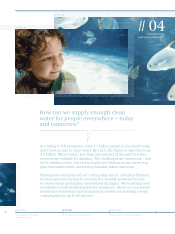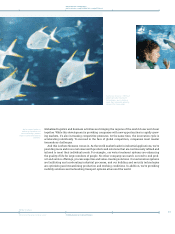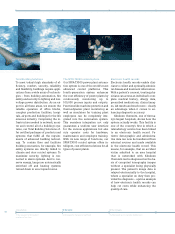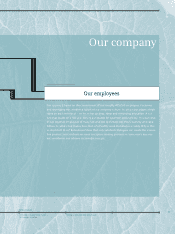Siemens 2009 Annual Report Download - page 37
Download and view the complete annual report
Please find page 37 of the 2009 Siemens annual report below. You can navigate through the pages in the report by either clicking on the pages listed below, or by using the keyword search tool below to find specific information within the annual report.-
 1
1 -
 2
2 -
 3
3 -
 4
4 -
 5
5 -
 6
6 -
 7
7 -
 8
8 -
 9
9 -
 10
10 -
 11
11 -
 12
12 -
 13
13 -
 14
14 -
 15
15 -
 16
16 -
 17
17 -
 18
18 -
 19
19 -
 20
20 -
 21
21 -
 22
22 -
 23
23 -
 24
24 -
 25
25 -
 26
26 -
 27
27 -
 28
28 -
 29
29 -
 30
30 -
 31
31 -
 32
32 -
 33
33 -
 34
34 -
 35
35 -
 36
36 -
 37
37 -
 38
38 -
 39
39 -
 40
40 -
 41
41 -
 42
42 -
 43
43 -
 44
44 -
 45
45 -
 46
46 -
 47
47 -
 48
48 -
 49
49 -
 50
50 -
 51
51 -
 52
52 -
 53
53 -
 54
54 -
 55
55 -
 56
56 -
 57
57 -
 58
58 -
 59
59 -
 60
60 -
 61
61 -
 62
62 -
 63
63 -
 64
64 -
 65
65 -
 66
66 -
 67
67 -
 68
68 -
 69
69 -
 70
70 -
 71
71 -
 72
72 -
 73
73 -
 74
74 -
 75
75 -
 76
76 -
 77
77 -
 78
78 -
 79
79 -
 80
80 -
 81
81 -
 82
82 -
 83
83 -
 84
84 -
 85
85 -
 86
86 -
 87
87 -
 88
88 -
 89
89 -
 90
90 -
 91
91 -
 92
92 -
 93
93 -
 94
94 -
 95
95 -
 96
96 -
 97
97 -
 98
98 -
 99
99 -
 100
100 -
 101
101 -
 102
102 -
 103
103 -
 104
104 -
 105
105 -
 106
106 -
 107
107 -
 108
108 -
 109
109 -
 110
110 -
 111
111 -
 112
112 -
 113
113 -
 114
114 -
 115
115 -
 116
116 -
 117
117 -
 118
118 -
 119
119 -
 120
120 -
 121
121 -
 122
122 -
 123
123 -
 124
124 -
 125
125 -
 126
126 -
 127
127 -
 128
128 -
 129
129 -
 130
130 -
 131
131 -
 132
132 -
 133
133 -
 134
134 -
 135
135 -
 136
136 -
 137
137 -
 138
138 -
 139
139 -
 140
140 -
 141
141 -
 142
142 -
 143
143 -
 144
144 -
 145
145 -
 146
146 -
 147
147 -
 148
148 -
 149
149 -
 150
150 -
 151
151 -
 152
152 -
 153
153 -
 154
154 -
 155
155 -
 156
156 -
 157
157 -
 158
158 -
 159
159 -
 160
160 -
 161
161 -
 162
162 -
 163
163 -
 164
164 -
 165
165 -
 166
166 -
 167
167 -
 168
168 -
 169
169 -
 170
170 -
 171
171 -
 172
172 -
 173
173 -
 174
174 -
 175
175 -
 176
176 -
 177
177 -
 178
178 -
 179
179 -
 180
180 -
 181
181 -
 182
182 -
 183
183 -
 184
184 -
 185
185 -
 186
186 -
 187
187 -
 188
188 -
 189
189 -
 190
190 -
 191
191 -
 192
192 -
 193
193 -
 194
194 -
 195
195 -
 196
196 -
 197
197 -
 198
198 -
 199
199 -
 200
200 -
 201
201 -
 202
202 -
 203
203 -
 204
204 -
 205
205 -
 206
206 -
 207
207 -
 208
208 -
 209
209 -
 210
210 -
 211
211 -
 212
212 -
 213
213 -
 214
214 -
 215
215 -
 216
216 -
 217
217 -
 218
218 -
 219
219 -
 220
220 -
 221
221 -
 222
222 -
 223
223 -
 224
224 -
 225
225 -
 226
226 -
 227
227 -
 228
228 -
 229
229 -
 230
230 -
 231
231 -
 232
232 -
 233
233 -
 234
234 -
 235
235 -
 236
236 -
 237
237 -
 238
238 -
 239
239 -
 240
240 -
 241
241 -
 242
242 -
 243
243 -
 244
244 -
 245
245 -
 246
246 -
 247
247 -
 248
248 -
 249
249 -
 250
250 -
 251
251 -
 252
252 -
 253
253 -
 254
254 -
 255
255 -
 256
256 -
 257
257 -
 258
258 -
 259
259 -
 260
260 -
 261
261 -
 262
262 -
 263
263 -
 264
264 -
 265
265 -
 266
266 -
 267
267 -
 268
268 -
 269
269 -
 270
270 -
 271
271 -
 272
272 -
 273
273 -
 274
274 -
 275
275 -
 276
276 -
 277
277 -
 278
278 -
 279
279 -
 280
280 -
 281
281 -
 282
282 -
 283
283 -
 284
284 -
 285
285 -
 286
286 -
 287
287 -
 288
288 -
 289
289 -
 290
290 -
 291
291 -
 292
292 -
 293
293 -
 294
294 -
 295
295 -
 296
296 -
 297
297 -
 298
298 -
 299
299 -
 300
300 -
 301
301 -
 302
302 -
 303
303 -
 304
304 -
 305
305 -
 306
306 -
 307
307 -
 308
308 -
 309
309 -
 310
310 -
 311
311 -
 312
312 -
 313
313 -
 314
314 -
 315
315 -
 316
316 -
 317
317 -
 318
318 -
 319
319 -
 320
320 -
 321
321 -
 322
322
 |
 |

5
www.siemens.com/answers
www.siemens.com/globalization-competitiveness
// 04
Globalization
and competitiveness
Totally Integrated Automation
Our Totally Integrated Automation
platform provides a homogeneous
environment for implementing cus-
tomized automation and drive solu-
tions in every type of industry. Me-
chanical and systems engineers,
systems integrators and end custom-
ers alike benefit from the end-to-end
harmonization of all production com-
ponents, products and systems. Opti-
mized processes cut lifecycle costs
while enhancing production opera-
tions. Already during the development
phase, we ensure that all products and
systems are seamlessly integrated –
optimizing interaction across genera-
tions and protecting customers’ earlier
investments.
Product lifecycle management
In an age of fast-paced technological
change and growing demand for cus-
tomized products, industrial equip-
ment and systems must be adapted to
current market needs more quickly,
flexibly and cost-effectively than ever
before. Throughout the entire product
development process, speed is a key
competitive advantage. In today’s in-
creasingly complex competitive land-
scape, conventional development and
production processes are reaching
their limits. That’s where the digital
factory is breaking new ground with
the simulation of production scenarios
– all the way from product conception
to the recycling phase. Product lifecy-
cle management (PLM) is the preferred
approach for transforming fledgling
ideas into successful products. Our
industrial software translates this con-
cept into proven solutions that are
open, scalable and flexible. Using our
PLM software, manufacturers can
simulate production steps and opera-
tional states, without the need for
costly real-world prototypes. In the
field of mechanical engineering, for
example, we offer PLM solutions that
span the entire process chain – from
computer-aided design and manufac-
turing to the construction of entire
virtual machines. The advantages:
time-to-market is accelerated consid-
erably, while end customers benefit
from improved product quality and
productivity.
Efficient energy management
With energy costs rising, competitive
pressures intensifying and climate
awareness increasing, concepts for
energy-optimized equipment and sys-
tems are sparking greater interest
than ever before. Today, the focus is
not only on procurement costs but on
a product’s entire lifecycle costs, in-
cluding operating outlays, energy
consumption and resource use. Cut-
ting costs by as much as percent,
our energy-saving motors and fre-
quency convertors for variable-speed
operation are pillars of efficient energy
management. Using our SinaSave
software tool, customers can easily
calculate how quickly their invest-
ments in energy-saving motors and
converters will pay for themselves.
66 Our structure
24 Climate change and energy supply 30 Globalization and competitiveness
